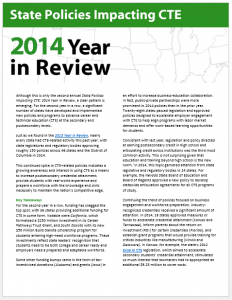We are back with another CTE Research Review. In this edition we explore business-facing intermediaries and a new study on reverse transfer students. And below the fold, we feature some studies and stories you may have missed in the last month.
How Intermediaries Create Shared Value by Connecting Youth with Jobs
The U.S. Chamber of Commerce Foundation is out with a new report in its Youth Employment Series titled Talent Orchestrators: Scaling Youth Employment through Business-Facing Intermediaries. The report challenges the notion that employer engagement is only a civic or philanthropic venture and outlines how business-facing intermediaries can create shared value by matching businesses with skilled youth. Already, intermediaries around the country are stepping up to the plate by managing employer demand, equipping youth with professional skills and job-specific training, and facilitating the onboarding process to connect youth with employment opportunities.
Consider STEP-UP Achieve, a career-track youth employment program started by Minneapolis-based intermediary AchieveMpls. The program partnered with the Minneapolis Regional Chamber to develop a curriculum and establish a certification endorsement for youth participants who successfully complete a pre-employment work-readiness program. This program, and others like it, created shared value by both preparing youth for the workplace and providing employers with a signal of job readiness. STEP-UP Achieve has provided more than 8,000 internship opportunities since 2004.
For Reverse Transfer Students, Going Backward Could Be the Best Path Forward
Speaking of alternative pathways to employment, a new research study from the Center for Analysis of Postsecondary Education and Employment (CAPSEE) examines academic and labor outcomes for struggling students who transfer from a four-year to a two-year postsecondary institution (aka “4-2 transfer studentsâ€). The study, Do Students Benefit from Going Backward? The Academic and Labor Market Consequences of Four-to Two-Year College Transfer, finds that struggling 4-2 transfer students are more likely to earn a postsecondary credential than similar students who do not transfer. What’s more, these students were no less likely than similar students to earn a bachelor’s degree and had similar earnings and employment rates. The outcomes of the study are promising because they suggest that struggling students can benefit from the flexibility and affordability of transferring to a two-year college without putting degree completion or future employment at risk.
ICYMI
And in case you missed it, here are some other studies and stories making a splash this month:
- The Institute for Higher Education Policy (IHEP) released a series of 11 policy papers about state and federal data policy. The series, Envisioning the National Postsecondary Infrastructure in the 21st Century, highlights recommendations for improving the national postsecondary data infrastructure from a working group of policy experts.
- A two-page brief from the National Association of State Boards of Education (NASBE) examines how states and LEAs can leverage policy opportunities to integrate Career Technical Education (CTE) into their college and career readiness strategies post-NCLB. Â
- Two months after the Lumina Foundation released its April update on college degree attainment, Inside Higher Ed examines how the Foundation’s new method of calculating postsecondary degree attainment, which now factors credential attainment into the total, affects Louisiana’s college completion goal.
- And if you haven’t already, you should check out The Journal of School & Society’s special issue on The Future of Vocational Education, which shares voices from educators and academics.
Austin Estes, Policy Associate



